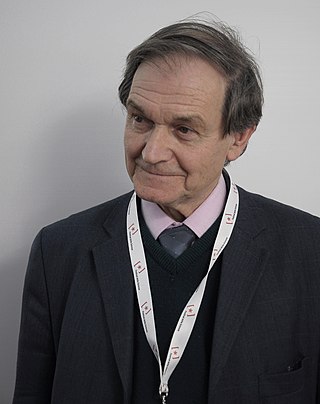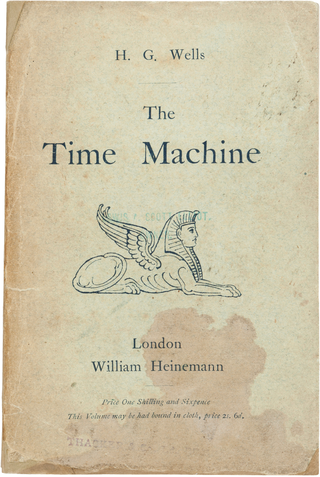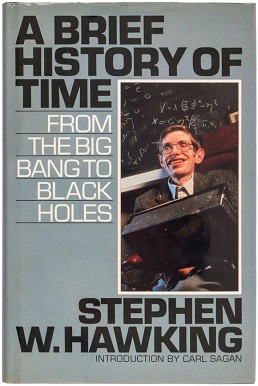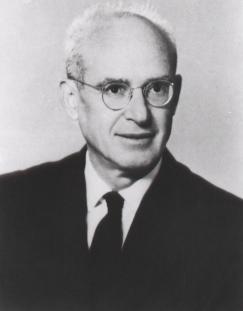The weak and the strong cosmic censorship hypotheses are two mathematical conjectures about the structure of gravitational singularities arising in general relativity.

General relativity, also known as the general theory of relativity and Einstein's theory of gravity, is the geometric theory of gravitation published by Albert Einstein in 1915 and is the current description of gravitation in modern physics. General relativity generalizes special relativity and refines Newton's law of universal gravitation, providing a unified description of gravity as a geometric property of space and time or four-dimensional spacetime. In particular, the curvature of spacetime is directly related to the energy and momentum of whatever matter and radiation are present. The relation is specified by the Einstein field equations, a system of second order partial differential equations.

Sir Roger Penrose, is a British mathematician, mathematical physicist, philosopher of science and Nobel Laureate in Physics. He is Emeritus Rouse Ball Professor of Mathematics in the University of Oxford, an emeritus fellow of Wadham College, Oxford, and an honorary fellow of St John's College, Cambridge, and University College London.

Time travel is the hypothetical activity of traveling into the past or future. Time travel is a widely recognized concept in philosophy and fiction, particularly science fiction. In fiction, time travel is typically achieved through the use of a hypothetical device known as a time machine. The idea of a time machine was popularized by H. G. Wells's 1895 novel The Time Machine.
A wormhole is a hypothetical structure connecting disparate points in spacetime, and is based on a special solution of the Einstein field equations.

A gravitational singularity, spacetime singularity or simply singularity is a condition in which gravity is predicted to be so intense that spacetime itself would break down catastrophically. As such, a singularity is by definition no longer part of the regular spacetime and cannot be determined by "where" or "when". Gravitational singularities exist at a junction between general relativity and quantum mechanics; therefore, the properties of the singularity cannot be described without an established theory of quantum gravity. Trying to find a complete and precise definition of singularities in the theory of general relativity, the current best theory of gravity, remains a difficult problem. A singularity in general relativity can be defined by the scalar invariant curvature becoming infinite or, better, by a geodesic being incomplete.

A Brief History of Time: From the Big Bang to Black Holes is a book on theoretical cosmology by English physicist Stephen Hawking. It was first published in 1988. Hawking wrote the book for readers who had no prior knowledge of physics.

The Large Scale Structure of Space–Time is a 1973 treatise on the theoretical physics of spacetime by the physicist Stephen Hawking and the mathematician George Ellis. It is intended for specialists in general relativity rather than newcomers.

Kip Stephen Thorne is an American theoretical physicist and writer known for his contributions in gravitational physics and astrophysics. Along with Rainer Weiss and Barry C. Barish, he was awarded the 2017 Nobel Prize in Physics for his contributions to the LIGO detector and the observation of gravitational waves.
The chronology protection conjecture is a hypothesis first proposed by Stephen Hawking that laws of physics beyond those of standard general relativity prevent time travel on all but microscopic scales - even when the latter theory states that it should be possible. The permissibility of time travel is represented mathematically by the existence of closed timelike curves in some solutions to the field equations of general relativity. The chronology protection conjecture should be distinguished from chronological censorship under which every closed timelike curve passes through an event horizon, which might prevent an observer from detecting the causal violation.

Nathan Rosen was an American-Israeli physicist noted for his study on the structure of the hydrogen atom and his work with Albert Einstein and Boris Podolsky on entangled wave functions and the EPR paradox. The Einstein–Rosen bridge, later named the wormhole, was a theory of Nathan Rosen.
Werner Israel, was a theoretical physicist known for his contributions to gravitational theory, and especially to the understanding of black holes.

Black Holes & Time Warps: Einstein's Outrageous Legacy is a 1994 popular science book by physicist Kip Thorne. It provides an illustrated overview of the history and development of black hole theory, from its roots in Newtonian mechanics until the early 1990s.
A ring singularity or ringularity is the gravitational singularity of a rotating black hole, or a Kerr black hole, that is shaped like a ring.

Robert M. Wald is an American theoretical physicist and professor at the University of Chicago. He studies general relativity, black holes, and quantum gravity and has written textbooks on these subjects.

General Relativity is a graduate textbook and reference on Albert Einstein's general theory of relativity written by the gravitational physicist Robert Wald.
The following outline is provided as an overview of and topical guide to black holes:

Jürgen Ehlers was a German physicist who contributed to the understanding of Albert Einstein's theory of general relativity. From graduate and postgraduate work in Pascual Jordan's relativity research group at Hamburg University, he held various posts as a lecturer and, later, as a professor before joining the Max Planck Institute for Astrophysics in Munich as a director. In 1995, he became the founding director of the newly created Max Planck Institute for Gravitational Physics in Potsdam, Germany.
ER = EPR is a conjecture in physics stating that two entangled particles are connected by a wormhole and is thought by some to be a basis for unifying general relativity and quantum mechanics into a theory of everything.












